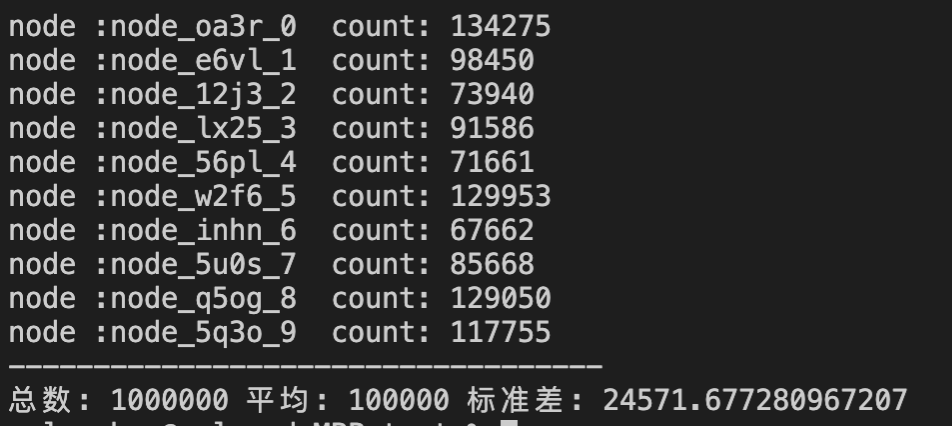一致性 hash
发布于: 2020 年 07 月 08 日

概览
数据保存:
数据的保存结构为map[string]*DataInfo,key为数据的key,DataInfo保存了原始数据data和该key的hash值keyHash(避免重复计算)
节点数据:
考虑到cache大部分操作都是获取KV,插入、删除数据都不会有节点数据相关的操作
节点信息保存在nodeList nodeListType,当需要获取节点下数据总数,遍历获取数据总数。
节点信息——node.go
package cachetype Node struct { begin uint32 // 起始位置,它为上一个节点的结束位置值 end uint32 // 结束位置 nodeName string // 节点名 virName string // 虚拟节点名}type nodeListType []*Nodefunc (n nodeListType) Len() int { return len(n)}func (n nodeListType) Swap(i, j int) { n[i], n[j] = n[j], n[i]}func (n nodeListType) Less(i, j int) bool { return n[i].end < n[j].end}
缓存信息——cache.go
package cacheimport ( "fmt" "hash/crc32" "sort")//获取hash值func hashkey(key string) uint32 { if len(key) < 64 { //声明一个数组长度为64 var srcatch [64]byte //拷贝数据到数组中 copy(srcatch[:], key) //使用IEEE 多项式返回数据的CRC-32校验和 return crc32.ChecksumIEEE(srcatch[:len(key)]) } return crc32.ChecksumIEEE([]byte(key))}var MAX_UINT uint32 = 4294967295type DataInfo struct { keyHash uint32 data interface{}}type Cache struct { nodeCount uint32 // 实际物理节点数 virtualCount int // 每个节点对应虚拟节点个数 nodeList nodeListType // 服务器节点列表 dataMap map[string]*DataInfo // 保存kv数据}// 添加节点func (c *Cache) AddNode(nodeName string) { c.nodeCount++ for i := 0; i < c.virtualCount; i++ { virName := fmt.Sprintf("%s_%d", nodeName, i) hashVal := hashkey(virName) // 插入到节点列表中 c.nodeList = append(c.nodeList, &Node{ begin: 0, end: hashVal, nodeName: nodeName, virName: virName}) } // 重新排序 sort.Sort(c.nodeList) // 重新计算起始区间 tmp := c.nodeList[0] length := len(c.nodeList) tmp.begin = c.nodeList[length-1].end // 起始节点,以最后一个节点作为结束 for i := 1; i < length; i++ { c.nodeList[i].begin = tmp.end tmp = c.nodeList[i] }}// 添加元素func (c *Cache) Add(key string, val interface{}) { c.dataMap[key] = &DataInfo{ data: val, keyHash: hashkey(key), }}// 删除元素func (c *Cache) Del(key string) { delete(c.dataMap, key)}// 获取key所在的节点func (c *Cache) GetNodeName(key string) (nodeName string, virName string) { nodeName = "" virName = "" length := len(c.nodeList) if length == 0 { return } hash := hashkey(key) idx := sort.Search(length, func(i int) bool { return c.nodeList[i].end >= hash }) if idx >= length { // 超出最后一个节点,取第一个节点最近 idx = 0 } nodeName = c.nodeList[idx].nodeName virName = c.nodeList[idx].virName return}// 获取节点下的数据总数func (c *Cache) GetNodeDataCount(nodeName string) int { nodeLst := []*Node{} for i := 0; i < len(c.nodeList); i++ { if c.nodeList[i].nodeName == nodeName { nodeLst = append(nodeLst, c.nodeList[i]) } } length := len(nodeLst) if length == 0 { return 0 } total := 0 for _, v := range c.dataMap { for _, node := range nodeLst { if node.begin > node.end { // 处理第一节点 if (node.begin < v.keyHash && v.keyHash <= MAX_UINT) || (0 <= v.keyHash && v.keyHash <= node.end) { total++ } } else if node.begin < v.keyHash && v.keyHash <= node.end { total++ } } } return total}func (c *Cache) PrintNodeList() { for _, v := range c.nodeList { fmt.Println("node:", v.begin, v.end, v.virName) } fmt.Println("total:", len(c.nodeList))}// 创建缓存func CreateCache(virtualCnt int) *Cache { return &Cache{virtualCount: virtualCnt, dataMap: map[string]*DataInfo{}}}
测试
package mainimport ( "fmt" "math" "math/rand" "test/cache" "time")func GetRandomString(l int) string { str := "0123456789abcdefghijklmnopqrstuvwxyz" bytes := []byte(str) result := []byte{} r := rand.New(rand.NewSource(time.Now().UnixNano())) for i := 0; i < l; i++ { result = append(result, bytes[r.Intn(len(bytes))]) } return string(result)}func CalcStandardDeviation(lst []float64, agv float64, total float64) float64 { var tmp float64 = 0 for i := 0; i < len(lst); i++ { tmp += math.Pow(lst[i]-agv, 2) } return math.Sqrt(tmp / 10)}func main() { nodeCount := 10 virNodeCount := 150 c := cache.CreateCache(virNodeCount) // 添加节点 nodeLst := []string{} for i := 0; i < nodeCount; i++ { nodeName := fmt.Sprintf("node_%s_%d", GetRandomString(4), i) c.AddNode(nodeName) nodeLst = append(nodeLst, nodeName) } // 添加数据 for i := 0; i < 1000000; i++ { key := fmt.Sprintf("%s_%d", GetRandomString(6), i) c.Add(key, i) } c.PrintNodeList() fmt.Println("-----------------------------------") // 打印节点对应数据数量 total := 0 countList := []float64{} for i := 0; i < nodeCount; i++ { nodeName := nodeLst[i] cnt := c.GetNodeDataCount(nodeLst[i]) fmt.Printf("node :%s count: %d\n", nodeName, cnt) total += cnt countList = append(countList, float64(cnt)) } fmt.Println("-----------------------------------") // 标准差计算 var agv float64 = float64(total) / float64(nodeCount) fmt.Println("总数:", total, "平均:", agv, "标准差:", CalcStandardDeviation(countList, float64(agv), float64(total)))}
结果输出

划线
评论
复制
发布于: 2020 年 07 月 08 日阅读数: 65
版权声明: 本文为 InfoQ 作者【GalaxyCreater】的原创文章。
原文链接:【http://xie.infoq.cn/article/a0f3ce2846330f0c1a1751a30】。
本文遵守【CC-BY 4.0】协议,转载请保留原文出处及本版权声明。
还未添加个人签名 2019.04.21 加入
还未添加个人简介












评论